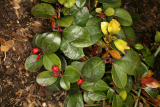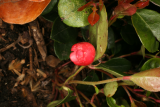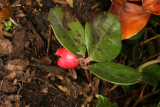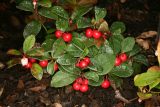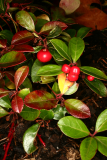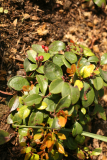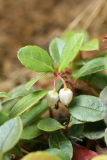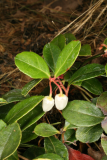Additional notes (click to expand)
Commemorative
It was named for the French physician and botanist, Jean-François Gaultier (1708–56). He was born in France, practised medicine in Paris and became physician to the king in 1741. He was friendly with the botanists from the Académie Royale des Sciences in Paris, Antoine de Jussieu (1686– 1758) and Bernard de Jussieu (1699–1777), and it may well be that his interest in botany was already evident then. He sailed to Canada in 1742 where he became involved in plant collecting and the fur trade, practising medicine in Quebec at the Hôtel-Dieu Hospital. He set up the fi rst meteorological station in Canada (1742), but his major botanical work was a 400-page manuscript on the plants of Canada in preparation for a six-volume book on the flora of North America. This was never published because of the war between the French Canadians and the English. He helped the botanist Pehr Kalm to explore the area around Quebec (1749), and the
grateful Kalm named Gaultheria in his honour. By 1752, his income from his salary and the fur trade was considerable and he married a rich widow who (or which) made him very happy. General Montcalm’s arrival in Quebec to fi ght the British brought with it typhus; Gaultier contracted it and died (Dictionary of Canadian Biography Online).
Oakeley, Dr. Henry. (2012). Doctors in the Medicinal Garden. Plants named after physicians. Royal College of Physicians. p.68
link
Horticulture
In the family Ericaceae, Gaultheria procumbens is a slow growing, dwarf, evergreen shrub which thrives in North American forests. In the Medicinal Garden it edges a raised bed where it brightens the border in the coldest months with its shiny, red, aromatic berries. Male and female flowers are born on separate plants, so both are necessary to produce the fruits. In spring and summer pink-tinged white, bell-shaped fl owers appear. Like other members of the family Ericaceae, it requires humus-rich, acidic soil. It is fully hardy, but prefers a sheltered site and does not like to dry out. We keep it well watered in summer and mulch annually with leaf mould in spring (Clare Beacham).
Oakeley, Dr. Henry. (2012). Doctors in the Medicinal Garden. Plants named after physicians. Royal College of Physicians.
link
Medicinal
Cyclooxygenase inhibitor. Contains methyl salicylate used topically, as Oil of Wintergreen, for musculoskeletal conditions, which is converted in the body to salicylic acid. Latter used for removing warts and corns.
Oakeley, Dr. H.F. (2013). Medicines from RCP plants label list 5-2013.docx.
Other use
Gaultheria procumbens Kalm Ericaceae. Wintergreen, teaberry, boxberry, chickerberry. Distribution: North American forests. Named for French physician/botanist Jean Francois Gaultier (1708-1756). Physician to the French King, emigrated to Quebec in 1742. Researched flora of North America, died of typhus (Oakeley, 2012). Source of oil of wintergreen. Ten pounds of oil can be extracted from a ton of leaves. Toxic effects: Stupidity, swelling of the tongue, food craving, epigastric tenderness, vomiting, dyspnoea, hot skin, tachycardia, restlessness (MiIlspaugh, 1974). Active chemical is methyl salicylate. Used topically for musculo-skeletal conditions, it is converted to salicylic acid when absorbed. Excess use has caused a death. Salicylic acid is also used for warts and corns (first described by Dioscorides in 70CE); and for eczema when combined with steroids. Native Americans used an infusion for headaches, colds, medicinal tea, rheumatism, fevers and a multitude of other conditions (Moerman, 1998).
Oakeley, Dr. Henry F. (2013). Wellcome Library notes.
link
Herbal medicinal literature extols its many virtues for all manner of ills and describes the
berries being used as a tea, but repeatedly cautions that it is ‘not to be taken internally’.
The cautions may refer to the oil, for while the berries are reported as harmless, the oil
produced by steam distillation is almost pure methyl salicylate and has caused death when
ingested or applied too generously to the skin (Frohne, 2004). Small amounts are added
to toothpastes.
Oakeley, Dr. Henry. (2012). Doctors in the Medicinal Garden. Plants named after physicians. Royal College of Physicians.
link
Geographical distribution
- Northern America, Eastern Canada
- Northern America, North-Central U.S.A.
- Northern America, Northeastern U.S.A.
- Northern America, Southeastern U.S.A.
- Northern America, Western Canada
Podcast
Gaultheria procumbens L.
Family: ERICACEAEGenus: Gaultheria
Species: procumbens L.
Common names: Checkerberry; Teaberry; Creeping wintergreen
Distribution summary: Northern America
Habit: Shrub
Hardiness: H5 - Hardy; cold winter
Habitat: Understorey and margins of evergreen forest
Garden status: Not currently grown
Flowering months: July, August
Reason for growing: Commemorative, other use
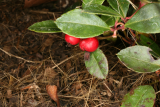
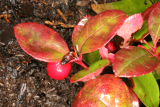
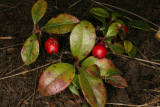
.JPG)
